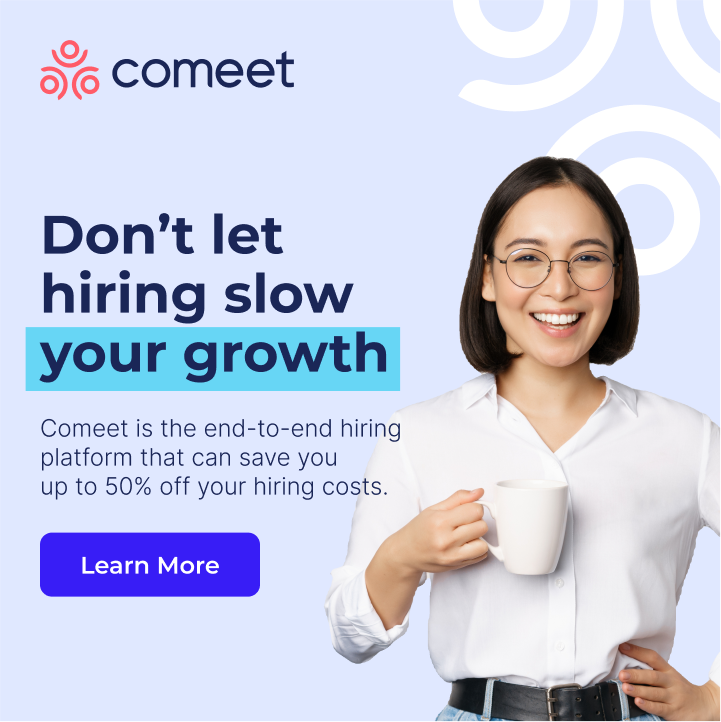As your company grows, your HR Tech needs become increasingly complex, and scaling your HR tech stack for efficiency may not be the most top of mind – but it should be.
Your HR tech stack, including all of the HR tools you use, must meet the needs of your organization both where it is and where it’s going in the near future. Don’t implement an HR tech tool that you cannot plan on using for at least two years. That’s why many high-growth companies get strong HR tech tools in place earlier than more traditional small businesses: because they expect to see that high level of growth. You don’t need an SMB tool if you aren’t planning to be an SMB for long! Instead, work toward an HR tech stack that is designed both to support your business today and to provide support as your business continues to grow.
Over the past ten years, I’ve had the chance to demo or use dozens of HR technology solutions and review potentially hundreds. Let’s take a look at how to best go about scaling your HR tech from seed to series B, hopefully using conversational and human language instead of technical HR terms.
How to Approach Software Selection and Implementation
Software selection and implementation is a huge subject that I can’t possibly do justice to in the time we have here. However, I’d like to offer a few general tips that can help you accomplish your goals.
Know Your Company
Think about the type of company you work at, what type of culture you have, and what type of person you are. For example, does the company value custom-built spreadsheet solutions over purpose-built software to “save” money, even though the development and maintenance time is often high? Do you enjoy building custom workflows and automations with free or low-cost tools?
Think about the company’s values, philosophies, frameworks, and growth trajectory. It’s helpful improve familiarity with your context before selecting and implementing any type of software solution, especially HR ones that are used by many people in the company and tend to be cross-functional. When you have that solid understanding of where you’re coming from, you put yourself in a better position to choose the tools that will best deliver on what your brand really needs.
Get Help If You Need It
If you’ve never done a successful HR technology selection and implementation before, then consider getting some extra support from a consulting company that specializes in HR Tech like DayoneHR. Botched HR technology implementations can cost your business a lot. In some cases, as an HR leader, it can even cost you your job! Don’t underestimate the time and work required to do it well, even in smaller organizations. If you need help, reach out. Getting help make the software selection process easier and more effective–and decrease the odds that you will make the same mistakes that others might have made in the past.
Early Stage: Seed or Series A
At this stage, your business is just getting off the ground. Scaling your HR tech may not be on your radar. You likely have between 3 and 50 employees and probably need at least three people processes that are best supported by technology, though your specific needs may depend on the complexity of your workforce, including their locations and employment status. One, common tool may do the job for a while, but general tools start to lose to purpose-built tools when you’re growing quickly or reach a certain scale. Rippling is a great place to start as an all-in-one.
As your business grows, you’ll start to identify places where you need to improve your tech stack: often specific modules that just aren’t delivering on your current needs. You can then replace the weak modules, including recruiting or performance management, with something purpose-built.
Hire People
Typically, the first thing you need is a way to recruit and hire people. You need an ATS (applicant tracking system). It’s important to get that ATS off the ground quickly so that you don’t have to worry about large-scale data loss or migration. I’ve seen companies start by just using the recruitment module their HRIS (human resource information system) includes, Google Docs and Forms, Notion, or AngelList. Each of these, however, have their own set of limitations. I’ve never heard of a company with a full-time recruiter who used those types of options. A strong ATS like Comeet, Greenhouse, or Lever can make a huge difference in your recruiting and tracking needs.
Most ATS companies like Comeet have a starter-type package to affordably support your business when it’s smaller, then offer pricing models that grow along with you. Before you get started, take a look at your specific business and what you need. Consider:
- Will an auto-scheduling option help you save time?
- What customer support options does the ATS offer?
- Do they do demos?
- Do they offer any value-add services to support you as you scale with your hiring process, like Elastic Sourcing by Comeet?
Check G2 reviews, talk to providers, and carefully evaluate your real business needs, rather than just selecting an ATS you’ve heard of before.
Pay People
Now that you’ve hired some amazing people, you need a way to pay them. There are a lot of factors that may go into selecting the right payment solution.
- Where are your team members? Are they all based only in the United States? What states are they in?
- Are your employees full-time or contractors?
If all of your employees are based in the United States, you can likely DIY with your Finance or HR team. Solutions like Gusto, Quickbooks Payroll, or Rippling can all offer the features you need. Other small business owners elect to outsource payroll to an accountant or bookkeeper. Finally, some choose to use a PEO like Justworks or Rippling.
If you have team members outside the United States, which has become increasingly common with many startups, the easiest way to pay them is with a solution like Papaya Global, Deel, or Pilot. Rippling also has a new solution for international employees. Make sure you look at:
- Overall cost
- Extra fees
- Locations from which your preferred solution can pay people
If you have questions about solutions that will allow you to easily pay people in other locations, talk to your team members in those locations to get a better feel for what services are common in those areas and what they have to offer.
Make sure, however, that you have a solid understanding of exactly what problems you’re trying to solve and what your business requirements are before starting the software selection process. Watch out for scope creep, when you try to get a single solution to solve much more than the initial problem. Instead, focus on the key issue at hand so you can choose a software solution that genuinely works for your business.
Support People
You’ve got the means to pay people. Now, you need a core Human Resource Information System (HRIS) that will allow you to provide support for your employees. You may have several options.
- Payroll and PEO companies may have basic HRIS functionality
- Spreadsheets
- Monday.com or similar programs
The best purpose-built HRIS in the US right now are Hibob, Rippling, and BambooHR. All of these are global solutions that have a strong presence in the US.
Mid-Level Stage: Late Series A or B
As a mid-level stage company, you continue to need to hire, pay, and support people, often at a deeper level. You may continue to add tools to your tech stack to support your growing company, which means that integrations become increasingly important. Not all integrations, however, are created equal. An integration that can push new employee data from your HRIS to your payroll software isn’t that valuable when you’re only hiring around 5 people per year. An integration that pushes all compensation changes from your HRIS to your payroll software when you have over 100 employees and frequent changes, on the other hand, is much more valuable to your productivity.
Keep in mind, however, that integrations are not the primary purpose of your software. Give them their due value, rather than placing excess weight on them.
Hire People
If you decided in the Early Stage to use a DIY or customized solution for hiring, it’s time to give it up. It will never scale. Go look at the Careers page of fast-growth companies like Monday.com, Hibob, or Papaya Global. None of them are using DIY solutions for their hiring, and with good reason.
As your company grows, you need a Core Talent Acquisition Platform (ATS) just like you need a Core People Platform (HRIS). If you have full-time recruiters and not many applicants, you definitely want an ATS that integrates with LinkedIn Recruiter to support passive candidate sourcing. There are many other platforms for recruitment, but the expensive “blue machine” still reigns supreme in the sourcing stage of the recruitment process.
I also recommend using outbound email campaigns to engage passive candidates in addition to sending LinkedIn InMails and connect requests. At Comeet, we use all three approaches for our Elastic Services. There are some very good purpose-built tools that run alongside LinkedIn Recruiter to help with this, including SourceWhale and Gem.
Your Employer Brand
At this stage, you also want to make sure that you’re investing heavily in your employer brands. That means tools like:
- Glassdoor
- BuiltIn
- Comparably
Monitor your Glassdoor page closely and respond to each review, even the negative ones. Take ownership and apologize for anything that was not the candidate or employee experience that you aim to offer. Candidates are people and know that companies make mistakes. It’s more important that you take ownership and engage, showing that you’re open to making changes and fixing problems than it is that you ignore and shirk responsibility for your mistakes.
Pay People
As long as you’re still only hiring full-time employees and contractors in the United States, you should still be good with tools like Justworks or Gusto. If your team is more global, I strongly suggest adding one of the global or remote team member payment options mentioned above. Rippling has the ability to handle both US-based and international payments, making it an excellent solution for teams that are looking for an all-in-one solution. Keep in mind, however, that their global payment options are still somewhat limited as they roll out new countries.
Benefits, Stock Options, and More
As your brand grows, hopefully, you are ready to start paying them with things like benefits and stock options, too. Of course, best practice would be to offer those things from the beginning; but better late than never! PEOs like Rippling and Justworks will handle the benefits side for you, but you may also want to go find your own benefit providers to add additional benefits not covered by your PEO. For example, you may want to add 401K benefits. You can use HumanInterest to set up a simple 401K with an employer match for your company.
Match the benefits your company offers to the type of talent the company has and wants to attract. Remote work and flexible hours are great benefits that also save the company money on expensive office space.
Your Finance team is probably still managing stock options in a spreadsheet. Carta, however, is a great tool to help with financial forecasting and managing stock options for the company. You may also want to do a better job of managing compensation with compensation benchmarking. Try Pave to help you manage and track important compensation benchmarks.
Support People
As we discussed before, your Core HR Platform should be able to scale to this point, at the least, with its core functionality. However, there are likely specific modules that are no longer able to support the level of sophistication required as your company matures. Typically, recruiting modules will need to be replaced first, followed by performance management tools.
Luckily, there are plenty of great performance management tools out there. Try:
- Leapsome
- CultureAmp
- 15Five
- Lattice
Start by determining the company’s performance management philosophy and company goal-setting framework, just as you would before choosing any other tool or software. Consider the company values, philosophy, and corresponding frameworks before selecting a software solution. This is especially important with performance management since it can be a controversial subject. Do you want a continuous or cyclical performance management style? Do you like the “rank and yank” format? Personally, I believe in treating people as genuine human beings with feelings, hopes, and dreams, not units of production or numbers in a financial model; and I hope that you will let similar beliefs guide your performance management philosophy and process.
Data Collection and Observation
As a talent leader, you’ll likely want to see more data, analytics, and reporting together than is available in a single system as your company continues to grow. You need more insight into large-scale data and information that can help guide your future decision-making and make it easier for you to manage your team. Check out Knoetic, a people analytics platform that can pull all HR and people data together in one place. With that simple shift, you can get more insights into your team’s performance and into what they really need.
Scaling Your HR Tech: Wrapping Up
Whether your company is at the Seed stage or moving toward Series B, I hope you’ve found practical information in this guide about scaling your HR tech that will help you move your brand forward. While it has left out entire HR tech software categories and controversial subjects, my goal is to provide a practical framework that will help you move forward with a more comprehensive understanding of the technology your brand really needs in order to excel. My hope is that it will inspire you to think strategically about your HR tech needs. Allow yourself to be guided by your company values, your philosophies, and your frameworks for technology selection. Of course, if you have specific HR tech needs, please feel free to reach out to me! Each company is unique and has specific use cases that I would be more than happy to discuss together as we come up with the tech stacks that will best serve your team.
These are tough times to be in HR. We are being laid off from companies left and right, often undervalued, and almost always under-invested in by the business. Your company, however, is lucky to have you–and your next company will be when they find you, if you’re looking for the next chapter in your professional story. As HR professionals, we’re in the ideal position to help organizations value the most important parts of their companies: their people. When you wake up tomorrow morning, remember this: today, you’re going to bring a little more equity, justice, and peace into the world through your work. How can you not love that?





























